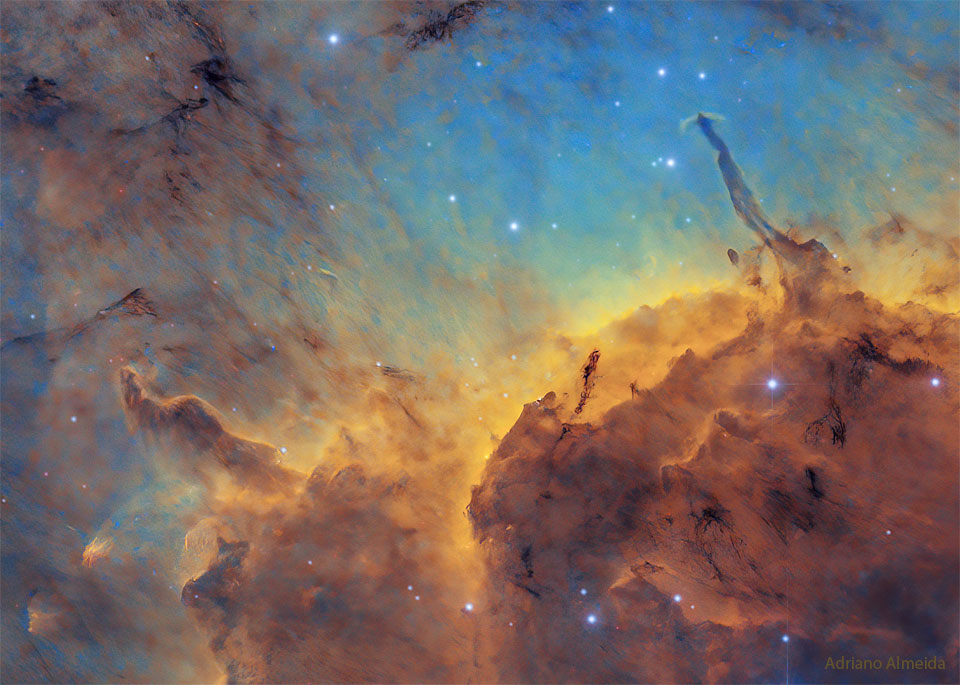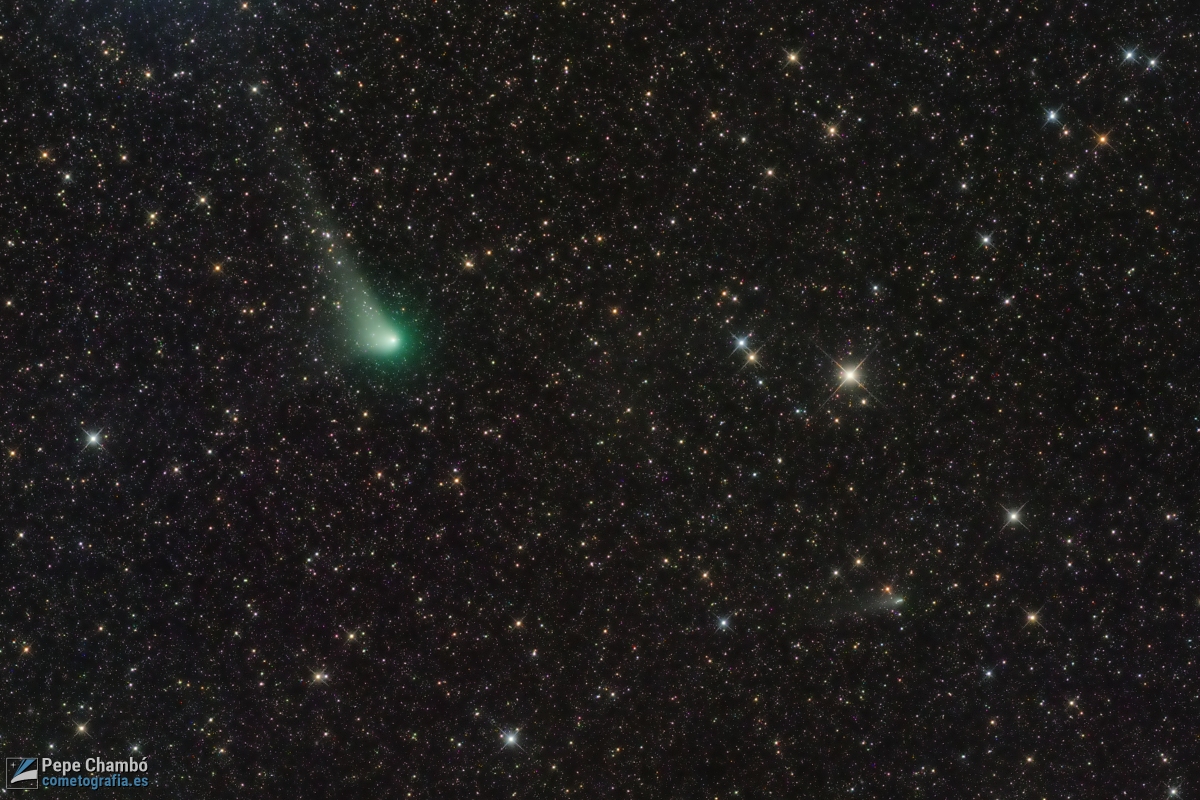Nombre total de pages vues
13/10/2022
AVIATION IMAGINEE - La montgolfière familiale
12/10/2022
ASTRONOMY - Ou4: The Giant Squid Nebula
2022 October 12
Image Credit & Copyright: Tommy Lease
Explanation: A mysterious squid-like cosmic cloud, this nebula is very faint, but also very large in planet Earth's sky. In the image, composed with 30 hours of narrowband image data, it spans nearly three full moons toward the royal constellation Cepheus. Discovered in 2011 by French astro-imager Nicolas Outters, the Squid Nebula's bipolar shape is distinguished here by the telltale blue-green emission from doubly ionized oxygen atoms. Though apparently surrounded by the reddish hydrogen emission region Sh2-129, the true distance and nature of the Squid Nebula have been difficult to determine. Still, a more recent investigation suggests Ou4 really does lie within Sh2-129 some 2,300 light-years away. Consistent with that scenario, the cosmic squid would represent a spectacular outflow of material driven by a triple system of hot, massive stars, cataloged as HR8119, seen near the center of the nebula. If so, this truly giant squid nebula would physically be over 50 light-years across.
11/10/2022
ASTRONOMY - Stars, Dust, Pillars, and Jets in the Pelican Nebula
2022 October 11
Image Credit & Copyright: Adriano Almeida
Explanation: What dark structures arise within the Pelican Nebula? On the whole, the nebula appears like a bird (a pelican) and is seen toward the constellation of a different bird: Cygnus, a Swan. But inside, the Pelican Nebula is a place lit up by new stars and befouled by dark dust. Smoke-sized dust grains start as simple carbon compounds formed in the cool atmospheres of young stars but are dispersed by stellar winds and explosions. Two impressive Herbig-Haro jets are seen emitted by the star HH 555 on the right, and these jets are helping to destroy the light year-long dust pillar that contains it. Other pillars and jets are also visible. The featured image was scientifically-colored to emphasize light emitted by small amounts of heavy elements in a nebula made predominantly of the light elements hydrogen and helium. The Pelican Nebula (IC 5067 and IC 5070) is about 2,000 light-years away and can be found with a small telescope to the northeast of the bright star Deneb.
10/10/2022
ASTRONOMY - A Double Lunar Analemma over Turkey
2022 October 10
Image Credit & Copyright: Betul Turksoy
Explanation: An analemma is that figure-8 curve you get when you mark the position of the Sun at the same time each day for one year. But the trick to imaging an analemma of the Moon is to wait bit longer. On average the Moon returns to the same position in the sky about 50 minutes and 29 seconds later each day. So photograph the Moon 50 minutes 29 seconds later on successive days. Over one lunation or lunar month it will trace out an analemma-like curve as the Moon's actual position wanders due to its tilted and elliptical orbit. Since the featured image was taken over two months, it actually shows a double lunar analemma. Crescent lunar phases too thin and faint to capture around the New moon are missing. The two months the persistent astrophotographer chose were during a good stretch of weather during July and August, and the location was Kayseri, Turkey
09/10/2022
08/10/2022
MACROPHOTOGRAPHIE - Miki Asai - Après le déluge une fourmi…
ASTRONOMIE - Ce soir une belle étreinte entre la Lune et Jupiter
Positions respectives de la planète Jupiter et de la Lune le 8 octobre 2022 vers 20h (heure de Paris). Le cercle bleu représente un champ de 6 degrés typique d’une paire de jumelles 10×50.
ASTRONOMY - Two Comets in Southern Skies
2022 October 8
Image Credit & Copyright: Jose J. Chambo (Cometografia)
Explanation: Heading for its closest approach to the Sun or perihelion on December 20, comet C/2017 K2 (PanSTARRS) remains a sight for telescopic observers as it sweeps through planet Earth's southern hemisphere skies. First time visitor from the remote Oort cloud this comet PanSTARRS sports a greenish coma and whitish dust tail about half a degree long at the upper left in a deep image from September 21. It also shares the starry field of view toward the constellation Scorpius with another comet, 73P/Schwassmann-Wachmann 3, seen about 1 degree below and right of PanSTARRS. Astronomers estimate that first time visitor comet C/2017 K2 (PanSTARRS) has been inbound from the Oort cloud for some 3 million years along a hyperbolic orbit. Schwassmann-Wachmann 3 is more familiar though. The periodic comet loops through its own elliptical orbit, from just beyond the orbit of Jupiter to the vicinity of Earth's orbit, once every 5.4 years. Just passing in the night, this comet PanSTARRS is about 20 light-minutes from Earth in the September 21 image. Seen to be disintegrating since 1995, Schwassmann-Wachmann 3 was about 7.8 light-minutes away.
07/10/2022
ASTRONOMY - In Ganymede's Shadow
Image Credit & Copyright: Andrew McCarthy
Explanation: At opposition, opposite the Sun in Earth's sky, late last month Jupiter is also approaching perihelion, the closest point to the Sun in its elliptical orbit, early next year. That makes Jupiter exceptionally close to our fair planet, currently resulting in excellent views of the Solar System's ruling gas giant. On September 27, this sharp image of Jupiter was recorded with a small telescope from a backyard in Florence, Arizona. The stacked video frames reveal the massive world bounded by planet girdling winds. Dark belts and light zones span the gas giant, along with rotating oval storms and its signature Great Red Spot. Galilean moon Ganymede is below and right in the frame. The Solar System's largest moon and its shadow are in transit across the southern Jovian cloud tops.
06/10/2022
ASTRONOMY - NGC 4631: The Whale Galaxy
2022 October 6
Image Credit & Copyright: Michael Sherick
Explanation: NGC 4631 is a big beautiful spiral galaxy. Seen edge-on, it lies only 25 million light-years away in the well-trained northern constellation Canes Venatici. The galaxy's slightly distorted wedge shape suggests to some a cosmic herring and to others its popular moniker, The Whale Galaxy. Either way, it is similar in size to our own Milky Way. In this sharp color image, the galaxy's yellowish core, dark dust clouds, bright blue star clusters, and red star forming regions are easy to spot. A companion galaxy, the small elliptical NGC 4627 is just above the Whale Galaxy. Faint star streams seen in deep images are the remnants of small companion galaxies disrupted by repeated encounters with the Whale in the distant past. The Whale Galaxy is also known to have spouted a halo of hot gas glowing in X-rays.
ASTRONOMY - HH-222: The Waterfall Nebula
2025 December 31 HH-222: The Waterfall Nebula Image Credit & Copyright: Mike Selby Explanation: What created the Waterfall Nebula? Th...

-
2022 September 26 All the Water on Planet Earth Illustration Credit: Jack Cook, Adam Nieman, Woods Hole Oceanographic Institution ; Data ...
-
2025 May 11 The Surface of Venus from Venera 14 Image Credit: Soviet Planetary Exploration Program , Venera 14 ; Processing & Copyri...








